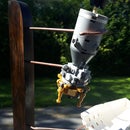Introduction: Lost the Nut on Your Guitar? No Problem, Here's How You Make Another
My favorite instrument is a cedar body Spanish classical guitar, but unfortunately, when traveling across country, it got a bit to much sunlight and started to warp around the bridge. So, I removed all the strings and humidified the body, which worked, but took almost a month to get it back to shape. When it came to restringing it, I realized that I had lost the nut in the process. Well, that wasn't to big a deal so I did a bit of calling around and found that none of the music stores, in my area carried one large enough to fit the neck of a classical. That's when I decided I would make one myself. Having a dog that loves bones, it seemed like the logical choice of materials and so I proceeded to get to work, commandeering one of her horde, and planned on how to make a replacement nut.
I suppose this process can be adapted, pretty easily to creating a custom nut for your guitar leaving your stock nut unmodified. I created this one out of bone but there's a plethora of materials you can use such as ebony, horn etc.
Step 1: Materials and Equipment
Supplies;
- Sandpaper - 220, 400, 600 wet
- 1 cow leg bone - Soup bones work great, just try to pick one with the thickest walls.
Here's the thing with dogs. They leave bones everywhere and only want them when you do so I had to play this one a little close to the chest when 'acquiring' mine, otherwise the sad looks, I'd receive for the rest of the night, would have given me cavities.
**important** If you choose to use bone as your nut making material, make sure they're raw and not cooked. I feed my dog raw frozen bones and never give her cooked as it makes them brittle and subject to splinters. I'd recommend not using a cooked one for the same reason.
Equipment:
- Saw - circular, coping, table, whatever you have on hand, but for cutting bone quickly, nothing beats a circular or table saw. Just set the depth on low and start slicing.
- Sander - belt or disk. This will make the shaping process a lot easier.
- Micro Files - for filing the string grooves
- Vernier Calipers - precision is important. Don't guess
Step 2: If You Don't Know...Measure
This is where the vernier calipers come in very handy. In fact I really couldn't have done this job without them so take that as an advisement to get a set if you don't already have one. By measuring the groove I was able to conclude that the nut should be 2" long, with a width of .2" and depth of .297". Not knowing the height of the original nut, and not finding any info on the maker's website I settled on a height of .5". That way, if the action was to high I could sand the base and lower it as necessary.
Step 3: Cutting the Bone
For me, it was as simple as setting the bone in my bench vice, setting the depth of my circular saw to shallow and slicing away. You can do this by hand, but bone is very dense and doesn't cut easily so I wouldn't recommend it.
As you can see the fragment I took was slightly bigger than what I needed, but we'll reduce that in the next step.
Step 4: Reducing the Nut
Keep a close eye on the dimensions by measuring and marking frequently with your vernier. Again, you want to keep the overall dimensions slightly larger and reduce as necessary. As my father would say, "you can remove material but you can't put it back". Better having to take off more in nibble sized increments than aggressively sand to much off.
Once you have a decent shaped block that's roughly to size, then you can move on to the next step.
Step 5: Setting and Filing Your String Grooves
With an overall width, of 2", I needed to space the grooves at .33" apart. There are custom guys out there, I'm sure, that will pipe up and say that the different strings should have slightly different spacing, and they're right, however after measuring some of the nuts on my other guitars, I realized that only one of the three actually had staggered spacing, so I figured symmetrical spacing wouldn't cause to much of a problem.
When deciding how far in I should set the high and low E strings, I took my original measurement of .33" and divided by 2, giving me .17" from each edge.
I started the grooves using my coping saw, just to make an indentation at the string locations. This would help keep the file from skating and ruining the surface as I widened the grooves to accommodate the strings.
Filing the Grooves:
When filing the grooves there's three things you need to be conscious of;
The first is angle. As the strings transition from the head of the guitar to the nut there is a distinctive angle, so when filing your grooves, you'll need to file them at this angle.
The second is string width. Now, I don't see any harm in a standard width, and in fact, that's pretty much how I made mine, however you may want to adjust the width of your grooves to accommodate the different strings with Low E and G being the widest, A-D being next and B-High E being the narrowest.
The third is depth. Now honestly, my research is all over the board on this one, however I'd suggest a depth where 3/4 of the string sits comfortably in the groove and 1/4 rises above. That should be enough to prevent your strings skipping out without binding them, causing you issues when tuning.
Step 6: Final Sanding and Shaping
After you've set the grooves in your nut, you're going to want to round the square edges (excluding the bottom), and give the top a bevel on the side that faces the head of the guitar. I'd recommend doing this by hand using graduated sanding starting at 220 and finishing with a wet sanding at 600 grit. Be very careful when sanding the grooves as you can inadvertently end up widening them and ruining your work.
Step 7: Final Sizing
This is the part where you string your guitar loosely and test the
action (the distance from your strings to your fretboard). Your strings should sit high enough so that you don't end up with string buzz when played, but low enough so as to be depressed smoothly and easily.
Touch-up
You may want to do a few adjustments to your nut to improve things like string height or shape. Again, I recommend graduated sanding, checking frequently as you do.
Step 8: Finished
When you've adjusted the nut to your satisfaction, you're ready to
go. So enjoy having that old guitar that lost the nut years ago or that new modded, custom nut that's designed to give your guitar that perfect accent and get out and play.
As always, I hope you enjoy this instructable.




